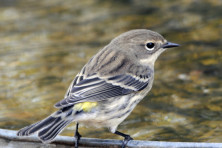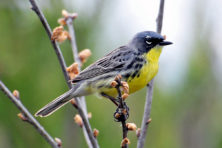The Warbler Wave
- Share
- Tweet
- Pin
- Share
Those elusive “all-of-a-sudden” warblers are finally arriving and building up their numbers in eastern Wisconsin. Many birders enjoy the challenges of finding and identifying these fascinating, colorful and fast-moving, “always-on-the-go” little birds as they search for midges and other small insects. Years ago someone came up with an excellent nickname for these birds – the “butterflies of the bird world.”
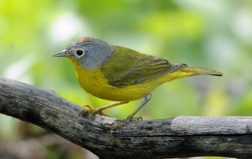
This adult Nashville Warbler shows red crown feathers which are often hidden.
One of my favorite wildlife artists, the great Francis Lee Jaques, concentrated on the large birds that didn’t move very fast, such as herons and geese, while his wife, an excellent birder and writer, favored the challenging warblers. Francis teased her by saying, “The difference between warblers and no warblers is very slight!” In a sense I agree with Francis, they are here one second and gone the next, but that adds to the excitement of birdwatching.
My first field guide to the birds, bought in 1954 while I was in the service, fortunately is filled with notes and dates opposite bird pictures and descriptions. I used that trusty well-worn book for 25 years before replacing it, but I still keep the old one for reference. A little note tucked within the warbler pages tells of spending Mother’s Day, May 13, 1961, with my mother and other family members in Kewaunee. It also turned out to be a super and memorable warbler day.
The warbler wave was on, as bird students would say. Tiny tree leaves were just unfolding, the air was warm, and tens of thousands of midges were hatching to provide food for those birds in the trees, shrubs and even on the ground.
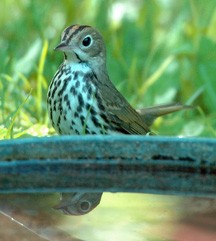
This adult Nashville Warbler shows red crown feathers which are often hidden.
I can vividly remember seeing my first male Black-throated Blue Warbler, not one but three or four. They fed quite low in one of the large Norway Spruces in my folks’ backyard, enabling me to approach to within six or eight feet of them. At the end of that remarkable backyard birding day my list included 19 species of warblers in addition to about 40 other bird species.
Roger Tory Peterson, famous birder, artist and writer specializing in the birds of North America, estimated that in most wooded areas of the U.S., one bird for every six is a warbler. In parts of the great coniferous forest of Canada, stretching nearly from the Atlantic to the Pacific Oceans, warblers make up more than one-half of all birds! By the way, warblers are restricted to the Americas and are not found in Europe. His estimate of the number of warblers in the Americas at one time was roughly one billion!
There are at least 54 species of warblers north of the Mexican border. Door County has 20 nesting species, as indicated in the first edition of the Atlas of the Breeding Birds of Wisconsin. The 20 species are: Blue-winged, Golden-winged, Nashville, Northern Parula, Yellow, Chestnut-sided, Magnolia, Cape May, Black-throated Blue, Yellow-rumped, Black-throated Green, Blackburnian, Pine, Black and White, American Redstart, Ovenbird, Northern Waterthrush, Mourning, Common Yellowthroat and Canada.
A few days ago I set up my bird observing and photographing blind (L.L Rue Photographic Equipment) in our front yard, about 15 feet from two birdbaths situated on the ground, and within an hour or so had photographed five of our state’s 20 species. They were the Golden-winged, Nashville, Cape May, Ovenbird and the Yellow-rumped Warblers. This is a marvelous way to not only get close to the birds for photographing but also to simply observe and enjoy them.
This morning, May 12, was the 23rd consecutive day that we’ve had Yellow-rumps at our suet feeders, both the purchased suet blocks suspended in a wire cage, and our marvel meal feeder. The weather being so unseasonably cold, insects have been very hard to find for the warblers and other small birds. These small warblers, needing food, obviously watched other birds go to the suet feeders, and it wasn’t long before they were doing the same thing. The fat in the suet and marvel meal feeders has been taking the place of insects. By the way, Yellow-rumps do nest in Door County, at least sparingly. I have observed and photographed them nesting at the Ridges Sanctuary and also at Whitefish Dunes State Park.
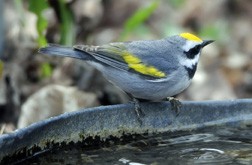
A Golden-winged Warbler is ready to take a bath.
As a rule, I do not go out looking for nesting birds to photograph, unless I can do it from 20 or 30 feet away. I learned my lesson many years ago at the Ridges Sanctuary when I decided to inspect a nesting site of Chickadees in the rotted-out top of a five-foot-tall tree stump. I returned the next day to the nest site with some friends to find that the stump had been ripped apart, the eggs eaten and nest destroyed.
Eventually I learned that when you walk up to a nest you leave behind a human scent trail that is easily followed by other animals. A Raccoon, for example, learns that a human scent trail may lead to the dog’s food dish outdoors, which also contains good Raccoon food. That animal is easily conditioned to follow other human scent trails, one of which may lead to a Chickadee’s nest and to the destruction of the eggs and nest.
Spring is the best time for warbler watching because the birds are in full-breeding plumage, and quite frequently are singing, making for much easier identification. Come fall, these birds have molted and lost their breeding plumage, and also the young of the year can be unusually difficult to identify. One’s birding skills improve from year to year, and it’s great fun to be with some of the highly accomplished veteran warbler watchers to hear them “rattle off” the names of one after another of the “all-of-a-sudden” warblers that never seem to sit still.
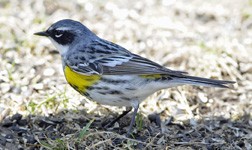
Many Yellow-rumped Warblers were here eating our suet for more than three weeks this spring.
I asked our friend Sue Peterson of Ephraim, perhaps Door County’s most experienced and skilled warbler watcher, to share some of her top sightings. Her day of most warbler species sightings at the Weborg Point area (campground, cemetery, marsh) at Peninsula State Park was on May 11, 2011. With about three hours of birding that morning she saw 23 species. Interestingly, the next day in the morning she saw 17 species of warblers, a terrific two-day slam!
The most uncommon sighting by Sue was a Blue-winged Warbler and Golden-winged Warbler Hybrid, seen on Aug. 24, 2005. Also rare at Weborg Point was the Hooded Warbler seen on May 9, 2002, and a Connecticut Warbler seen in September of 2010.
Get to know and use some of the warbler-viewing hotspots in Door County and have some great fun. It’ll give you something to warble about!

